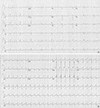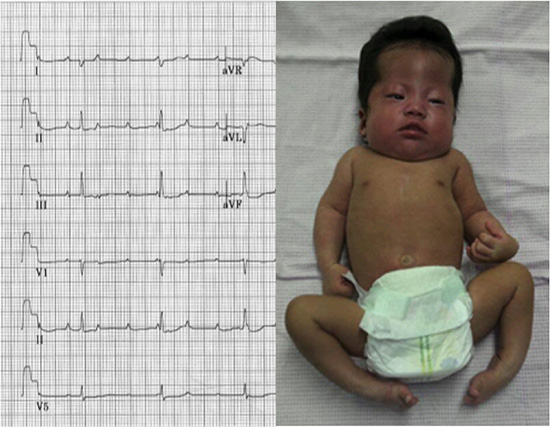1. Pelargonio G, Dello Russo A, Sanna T, De Martino G, Bellocci F. Myotonic dystrophy and the heart. Heart. 2002; 88:665–670.
3. Bassez G, Lazarus A, Desguerre I, Varin J, Laforêt P, Bécane HM, Meune C, Arne-Bes MC, Ounnoughene Z, Radvanyi H, et al. Severe cardiac arrhythmias in young patients with myotonic dystrophy type 1. Neurology. 2004; 63:1939–1941.
4. Igarashi H, Momoi MY, Yamagata T, Shiraishi H, Eguchi I. Hypertrophic cardiomyopathy in congenital myotonic dystrophy. Pediatr Neurol. 1998; 18:366–369.
5. Forsberg H, Olofsson BO, Eriksson A, Andersson S. Cardiac involvement in congenital myotonic dystrophy. Br Heart J. 1990; 63:119–121.
6. Campbell C, Sherlock R, Jacob P, Blayney M. Congenital myotonic dystrophy: assisted ventilation duration and outcome. Pediatrics. 2004; 113:811–816.
7. Rudnik-Schöneborn S, Nicholson GA, Morgan G, Röhrig D, Zerres K. Different patterns of obstetric complications in myotonic dystrophy in relation to the disease status of the fetus. Am J Med Genet. 1998; 80:314–321.
8. Buxton J, Shelbourne P, Davies J, Jones C, Van Tongeren T, Aslanidis C, de Jong P, Jansen G, Anvret M, Riley B, et al. Detection of an unstable fragment of DNA specific to individuals with myotonic dystrophy. Nature. 1992; 355:547–548.
9. Aslanidis C, Jansen G, Amemiya C, Shutler G, Mahadevan M, Tsilfidis C, Chen C, Alleman J, Wormskamp NG, Vooijs M, et al. Cloning of the essential myotonic dystrophy region and mapping of the putative defect. Nature. 1992; 355:548–551.
10. Brook JD, McCurrach ME, Harley HG, Buckler AJ, Church D, Aburatani H, Hunter K, Stanton VP, Thirion JP, Hudson T, et al. Molecular basis of myotonic dystrophy: expansion of a trinucleotide (CTG) repeat at the 3' end of a transcript encoding a protein kinase family member. Cell. 1992; 68:799–808.
11. Phillips MF, Harper PS. Cardiac disease in myotonic dystrophy. Cardiovasc Res. 1997; 33:13–22.
12. Petri H, Vissing J, Witting N, Bundgaard H, Køber L. Cardiac manifestations of myotonic dystrophy type 1. Int J Cardiol. 2012; 160:82–88.
13. Michaëlsson M, Engle MA. Congenital complete heart block: an international study of the natural history. Cardiovasc Clin. 1972; 4:85–101.
14. Udink ten Cate FE, Sreeram N. Pacing therapy in infants and children with congenital and acquired complete atrioventricular block: optimal pacing strategies, management, and follow-up. In : Das MK, editor. Modern pacemakers - present and future. Intech Publisher;2011. p. 89–117.
15. Epstein AE, DiMarco JP, Ellenbogen KA, Estes NA 3rd, Freedman RA, Gettes LS, Gillinov AM, Gregoratos G, Hammill SC, Hayes DL, et al. ACC/AHA/HRS 2008 guidelines for device-based therapy of cardiac rhythm abnormalities: a report of the American College of Cardiology/American Heart Association Task Force on Practice Guidelines (writing committee to revise the ACC/AHA/NASPE 2002 guideline update for implantation of cardiac pacemakers and antiarrhythmia devices) developed in collaboration with the American Association for Thoracic Surgery and Society of Thoracic Surgeons. J Am Coll Cardiol. 2008; 51:e1–e62.
16. Friedman RA, Fenrich AL, Kertesz NJ. Congenital complete atrioventricular block. Pacing Clin Electrophysiol. 2001; 24:1681–1688.
17. Maginot KR, Mathewson JW, Bichell DP, Perry JC. Applications of pacing strategies in neonates and infants. Prog Pediatr Cardiol. 2000; 11:65–75.








 PDF
PDF ePub
ePub Citation
Citation Print
Print




 XML Download
XML Download